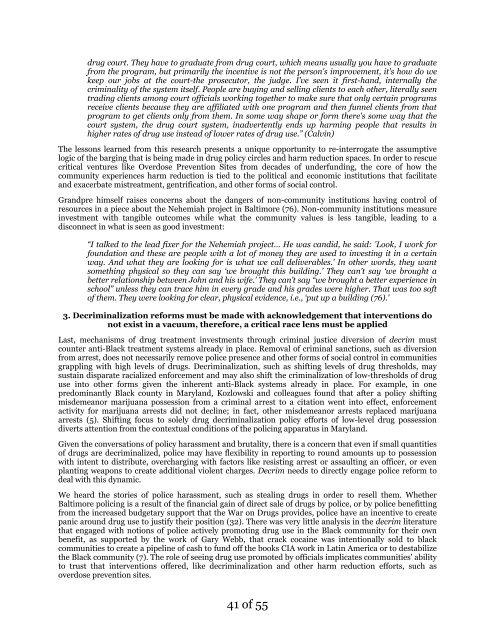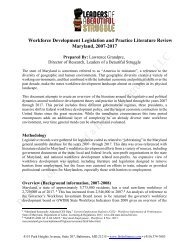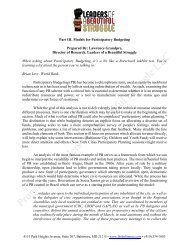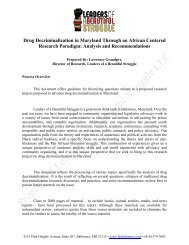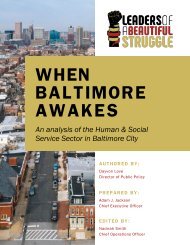The Communal Impacts of Drug Criminalization in Maryland
This project attempts to reframe the harms of drug criminalization. Influenced by African-Centered Research Methodologies, we engaged in a literature review and qualitative research of the communal impacts of drug decriminalization in Maryland, with a specific focus on Baltimore.
This project attempts to reframe the harms of drug criminalization. Influenced by African-Centered Research Methodologies, we engaged in a literature review and qualitative research of the communal impacts of drug decriminalization in Maryland, with a specific focus on Baltimore.
You also want an ePaper? Increase the reach of your titles
YUMPU automatically turns print PDFs into web optimized ePapers that Google loves.
drug court. <strong>The</strong>y have to graduate from drug court, which means usually you have to graduate<br />
from the program, but primarily the <strong>in</strong>centive is not the person's improvement, it's how do we<br />
keep our jobs at the court-the prosecutor, the judge. I’ve seen it first-hand, <strong>in</strong>ternally the<br />
crim<strong>in</strong>ality <strong>of</strong> the system itself. People are buy<strong>in</strong>g and sell<strong>in</strong>g clients to each other, literally seen<br />
trad<strong>in</strong>g clients among court <strong>of</strong>ficials work<strong>in</strong>g together to make sure that only certa<strong>in</strong> programs<br />
receive clients because they are affiliated with one program and then funnel clients from that<br />
program to get clients only from them. In some way shape or form there's some way that the<br />
court system, the drug court system, <strong>in</strong>advertently ends up harm<strong>in</strong>g people that results <strong>in</strong><br />
higher rates <strong>of</strong> drug use <strong>in</strong>stead <strong>of</strong> lower rates <strong>of</strong> drug use.” (Calv<strong>in</strong>)<br />
<strong>The</strong> lessons learned from this research presents a unique opportunity to re-<strong>in</strong>terrogate the assumptive<br />
logic <strong>of</strong> the barg<strong>in</strong>g that is be<strong>in</strong>g made <strong>in</strong> drug policy circles and harm reduction spaces. In order to rescue<br />
critical ventures like Overdose Prevention Sites from decades <strong>of</strong> underfund<strong>in</strong>g, the core <strong>of</strong> how the<br />
community experiences harm reduction is tied to the political and economic <strong>in</strong>stitutions that facilitate<br />
and exacerbate mistreatment, gentrification, and other forms <strong>of</strong> social control.<br />
Grandpre himself raises concerns about the dangers <strong>of</strong> non-community <strong>in</strong>stitutions hav<strong>in</strong>g control <strong>of</strong><br />
resources <strong>in</strong> a piece about the Nehemiah project <strong>in</strong> Baltimore (76). Non-community <strong>in</strong>stitutions measure<br />
<strong>in</strong>vestment with tangible outcomes while what the community values is less tangible, lead<strong>in</strong>g to a<br />
disconnect <strong>in</strong> what is seen as good <strong>in</strong>vestment:<br />
“I talked to the lead fixer for the Nehemiah project… He was candid, he said: 'Look, I work for<br />
foundation and these are people with a lot <strong>of</strong> money they are used to <strong>in</strong>vest<strong>in</strong>g it <strong>in</strong> a certa<strong>in</strong><br />
way. And what they are look<strong>in</strong>g for is what we call deliverables.’ In other words, they want<br />
someth<strong>in</strong>g physical so they can say ‘we brought this build<strong>in</strong>g.’ <strong>The</strong>y can’t say ‘we brought a<br />
better relationship between John and his wife.’ <strong>The</strong>y can’t say “we brought a better experience <strong>in</strong><br />
school” unless they can trace him <strong>in</strong> every grade and his grades were higher. That was too s<strong>of</strong>t<br />
<strong>of</strong> them. <strong>The</strong>y were look<strong>in</strong>g for clear, physical evidence, i.e., ‘put up a build<strong>in</strong>g (76).'<br />
3. Decrim<strong>in</strong>alization reforms must be made with acknowledgement that <strong>in</strong>terventions do<br />
not exist <strong>in</strong> a vacuum, therefore, a critical race lens must be applied<br />
Last, mechanisms <strong>of</strong> drug treatment <strong>in</strong>vestments through crim<strong>in</strong>al justice diversion <strong>of</strong> decrim must<br />
counter anti-Black treatment systems already <strong>in</strong> place. Removal <strong>of</strong> crim<strong>in</strong>al sanctions, such as diversion<br />
from arrest, does not necessarily remove police presence and other forms <strong>of</strong> social control <strong>in</strong> communities<br />
grappl<strong>in</strong>g with high levels <strong>of</strong> drugs. Decrim<strong>in</strong>alization, such as shift<strong>in</strong>g levels <strong>of</strong> drug thresholds, may<br />
susta<strong>in</strong> disparate racialized enforcement and may also shift the crim<strong>in</strong>alization <strong>of</strong> low-thresholds <strong>of</strong> drug<br />
use <strong>in</strong>to other forms given the <strong>in</strong>herent anti-Black systems already <strong>in</strong> place. For example, <strong>in</strong> one<br />
predom<strong>in</strong>antly Black county <strong>in</strong> <strong>Maryland</strong>, Kozlowski and colleagues found that after a policy shift<strong>in</strong>g<br />
misdemeanor marijuana possession from a crim<strong>in</strong>al arrest to a citation went <strong>in</strong>to effect, enforcement<br />
activity for marijuana arrests did not decl<strong>in</strong>e; <strong>in</strong> fact, other misdemeanor arrests replaced marijuana<br />
arrests (5). Shift<strong>in</strong>g focus to solely drug decrim<strong>in</strong>alization policy efforts <strong>of</strong> low-level drug possession<br />
diverts attention from the contextual conditions <strong>of</strong> the polic<strong>in</strong>g apparatus <strong>in</strong> <strong>Maryland</strong>.<br />
Given the conversations <strong>of</strong> policy harassment and brutality, there is a concern that even if small quantities<br />
<strong>of</strong> drugs are decrim<strong>in</strong>alized, police may have flexibility <strong>in</strong> report<strong>in</strong>g to round amounts up to possession<br />
with <strong>in</strong>tent to distribute, overcharg<strong>in</strong>g with factors like resist<strong>in</strong>g arrest or assault<strong>in</strong>g an <strong>of</strong>ficer, or even<br />
plant<strong>in</strong>g weapons to create additional violent charges. Decrim needs to directly engage police reform to<br />
deal with this dynamic.<br />
We heard the stories <strong>of</strong> police harassment, such as steal<strong>in</strong>g drugs <strong>in</strong> order to resell them. Whether<br />
Baltimore polic<strong>in</strong>g is a result <strong>of</strong> the f<strong>in</strong>ancial ga<strong>in</strong> <strong>of</strong> direct sale <strong>of</strong> drugs by police, or by police benefitt<strong>in</strong>g<br />
from the <strong>in</strong>creased budgetary support that the War on <strong>Drug</strong>s provides, police have an <strong>in</strong>centive to create<br />
panic around drug use to justify their position (32). <strong>The</strong>re was very little analysis <strong>in</strong> the decrim literature<br />
that engaged with notions <strong>of</strong> police actively promot<strong>in</strong>g drug use <strong>in</strong> the Black community for their own<br />
benefit, as supported by the work <strong>of</strong> Gary Webb, that crack coca<strong>in</strong>e was <strong>in</strong>tentionally sold to black<br />
communities to create a pipel<strong>in</strong>e <strong>of</strong> cash to fund <strong>of</strong>f the books CIA work <strong>in</strong> Lat<strong>in</strong> America or to destabilize<br />
the Black community (7). <strong>The</strong> role <strong>of</strong> see<strong>in</strong>g drug use promoted by <strong>of</strong>ficials implicates communities' ability<br />
to trust that <strong>in</strong>terventions <strong>of</strong>fered, like decrim<strong>in</strong>alization and other harm reduction efforts, such as<br />
overdose prevention sites.<br />
41 <strong>of</strong> 55


